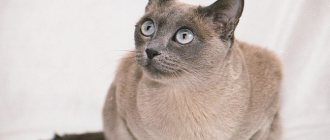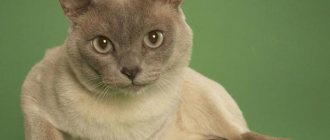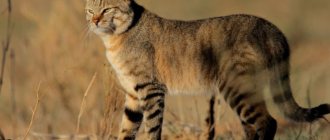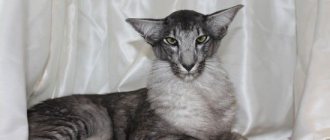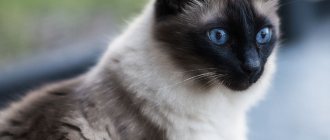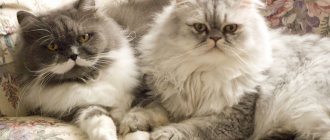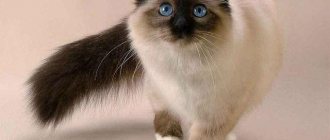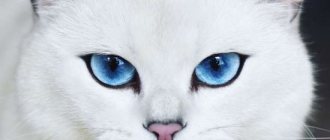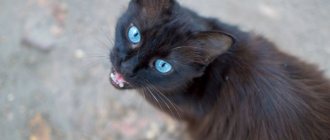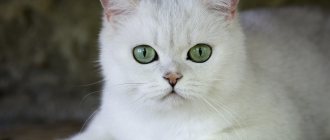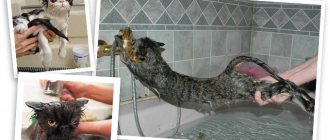Brief history of the breed
In ancient times, unusual cats with dark paws, muzzles and tails lived at the temples of Burma. They differed from the Siamese in their calmer character, stronger physique and less contrasting colors.
In the 1930s, one of these cats was given to J. Thompson by sailors. She was named Wong Mau and began to be bred with the old-type Siamese. As a result of crossings, kittens of different colors were born: with bright markings, with barely visible or completely absent masks.
Later, breeders identified 4 types of color in these animals. On their basis, the Burmese breed was formed, the representatives of which had golden eyes. However, such litters often produced kittens with blue irises and a slightly different coat color.
Burmese breeders mercilessly culled non-standard individuals. And it is unknown what would have happened to these animals if they had not had fans. A group of enthusiasts, which included Margaret Conroy and Jane Barletta, decided to breed another breed based on the descendants of Wong Mau.
To achieve their goal, they began crossing Burmese cats with the old-type Siamese. As a result of this, Tonkinesis was born. The breed was officially recognized by the CFA in 1984.
Colors
This is the only cat whose six, one of the main advantages of the breed, are compared to a mink. It was the delicate shades of color and its brilliant gloss - glitter - that gave the colors such a name.
There are five main colors of the Tonkinese cat. Their characteristics:
- Natural mink. The main background is light brown, the points are dark brown. The abdomen and inner surfaces of the paws are lighter than the rest of the body. The paw pads and nose are light to dark brown.
- Honey mink. The main background is cream with a golden-apricot tint. The points are red-brown of varying intensity. The paw pads and nose are the color of pink caramel.
- Champagne. The main background is light cream, the points are light brown. The paw pads and nose are a cinnamon shade of varying intensity.
- Blue mink. The main background is light gray with a bluish tint, the points are darker, smoky blue. Paw pads and nose - match the background color.
- Platinum mink. The main background is silver-gray, almost purple. Points are the same color, but more saturated with a purple gloss. The paw pads and nose are pink to gray with a lavender tint.
Some felinological systems combine honey and champagne mink into one category. In addition, the Siamese type of color is sometimes recognized - with a clear contrast from the background to the points, a solid Burmese color. The mink color is often classified as a mink color.
The formation of colors is completely completed no earlier than one and a half years. Therefore, in kittens and young individuals, lighter background colors and faint spots in the points are allowed.
Breed description, standards, appearance
The Tonkinese is a compact, well-proportioned cat with well-developed muscles and blue eyes. In 1979, the International Cat Association TICA officially approved a document that provides a complete description of these animals.
Also, the current breed standard contains a list of disqualifying characteristics, in the presence of which the Tonkinese cat is not allowed to exhibit and participate in the breeding program:
- yellow eyes;
- creases on the tail;
- white “medallions”;
- strabismus;
- protruding or sunken sternum.
Dimensions and weight
Tonkinese are medium-sized animals with moderate sexual dimorphism. The weight of cats of this breed ranges from 3-6 kg. Moreover, female Tonkinese snakes are always smaller and lighter than males.
Anatomical characteristics
According to the TICA standard, Tonkinese cats must meet the following description:
- The head is medium in size, shaped like a modified wedge with soft contours, a slightly convex forehead, high cheekbones and a slightly protruding nose.
- The eyes are medium sized and slant towards the outer edge of the ear. The lower eyelid of Tonkinese is slightly rounded, the upper one is almond-shaped. The iris is painted in an even aquamarine or light turquoise hue. The eye color of representatives of the Tonkinese cat breed is determined in natural light.
- The ears are medium-sized, slightly tilted forward, with a wide base and oval tips.
- The body is rectangular in format, with a moderately wide chest, slightly curved ribs, an elastic belly, well-developed muscles and a slightly raised croup.
- The limbs are thin, with oval paws. The hind legs of the Tonkinese cat are slightly longer than the front ones.
- The tail is of medium length, gradually tapering to a slightly blunt tip.
Color and coat type
The body of the Tonkinese cat is covered with short, soft and silky hair. It fits tightly to the body and has a natural shine.
Representatives of the Tonkinese breed are not characterized by a color with a clear contrast. All transitions between the main background and points are smoothed. The breed standard allows for the following color options:
- “natural mink” – with dark chocolate markings on a warm brown background;
- “blue mink” - with gray-blue spots on a blue background;
- “platinum mink” - with dark gray markings and a pale gray background;
- “champagne” - with pale brown spots and a light beige background.
Each of the above colors is divided into the following color groups:
- Point – resembles the color of a Siamese. Tonkinese with this coloration are characterized by blue eyes and a sharp contrast.
- Mink, also called mink. In this case, the Tonkinese cat has aquamarine eyes and a moderate contrast between areas of fur of different colors.
- Solid - similar to the Burmese coloring. Characterized by green or yellow-green eyes and poor contrast between areas of different colored fur.
Features and breed standard
In terms of morphology, the Tonkinese cat resembles a Thai cat, but has a shorter and wider, slightly snub nose. This is an animal of medium size and constitution with a peculiar coat and a characteristic color point. Derived from crossing a Siamese and a Burmese, it is distinguished by its aquamarine eye color.
Description given to this breed by WCF:
- Head. Wedge-shaped, quite wide. The profile and cheekbones are quite softly outlined, the stop is small in size on the bridge of the nose.
- Neck. Medium size, strong and muscular.
- Eyes. Quite widely spaced, almond-shaped, but slightly rounded. The color must match the coat. From aquamarine to seawater color. Preferably clean and clear tones.
- Ears. The middle ones are wider at the base, tapering to slightly rounded tips. High standing, straight, not too wide apart. The fur on the ears is short, the ears appear translucent.
- Body. Medium build, muscular, with a toned stomach. Not elegant, but not massive either.
- Paws. Medium size, quite graceful, but strong, pads are round, but quite small.
- Tail. Medium size, proportional to the body, slightly tapering towards the tip.
- Wool. Short and shiny. Without undercoat, lying close to the body.
- Color. The main background is without a pattern, uniform, somewhat lighter on the inner parts of the body. The points—the “mask” on the face, the ears, paws, and tail—are darker, the transition from the main background to the points is smoothed out.
- Weight. Males are larger than females. From three to six kilograms.
- Knitting. Interbreeding only within the breed
- Flaws. Slight deformation of the tail, too heavy or graceful body, large snub nose.
Disqualifying signs:
- Yellow eye color
- White spots and medallions
- Tail break
- Aggressive behavior.
Character and temperament
The Tonkinese cat has a playful and friendly disposition. She loves affection very much and always tries to be closer to her owners in order to get her share of attention.
Important! Tonkinese do not tolerate loneliness well and suffer from indifferent attitudes. In the absence of communication with people, cats of this breed begin to deteriorate in health and deteriorate in character.
Tonkinese get along well with kids, especially if they understand how to properly handle animals. It is generally accepted that contact with cats of this breed has a beneficial effect on the condition of children with mental disorders.
Kind and sociable Tonkinese get along well with other pets and will be truly happy if another pet settles next to them.
Tonkinese cat (Tonkinese) - reviews
- + Leave a review
Leave a review Reset
Nadezhda Tonk
https://irecommend.ru/content/udivitelnaya-koshka
My acquaintance with these amazing creatures took place a very long time ago. I once had cats of other breeds, but after the appearance of Tonkin cats, everything changed dramatically. I have never had such smart and humane cats. That’s why I call them not cats, but creatures, because they are almost not cats anymore. My friends call them “cat+dog+monkey+ferret+man”. They talk, and speak in complete sentences, answer your questions and tell you how they spent the day in your absence. They rumble, they always rumble :) When you look at them, when they want to attract your attention, when they sit on your lap or on your shoulder, when they sleep :) By the way, they sleep in the most imposing positions, preferably on the bed, and often under blanket - on the pillow. They are medicinal - this is an indisputable and confirmed fact. This particular breed of cat is even used in rehabilitation programs for disabled children and in zootherapy programs. This is a cat that will always participate in everything - it will help you around the house, garden, raise and nurse children. But they are also a very curious cat, for this reason they often have to be pulled out of various sticky situations and hard-to-reach places. But with proper attention and love on your part, this animal will create comfort in your home and give you joy. Another important point is that the Tonkinese have a magical ability to unite families and resolve family conflicts. They do not tolerate a tense situation in the house, and will do everything possible to soften and defuse it. These cats are very human-oriented. They need the presence of their beloved owner. They suffer a lot and feel abandoned when no one is home. Therefore, if you work all day, get your Tonkinese friend a second Tonkin, then in your absence they will not be bored, but imagine double the joy when they meet you at the doorstep :))
_Ilnar_
https://irecommend.ru/content/tonkinskaya-prelest-raduet-kazhdyi-den-provedennyi-u-roditelei-fotografii
I want to tell you about my parents’ beloved cat, who warms the heart of my parents’ home every day.
I’ll start from the very beginning, a very charming person has been living with my parents for the second year now, her name is Mila. She was given by a friend of my father, who breeds and sells rare breeds of cats, and everyone liked this gift. At first, this little miracle didn’t cause us much trouble, because she was shy and was just getting used to the new place.
After she completely settled into her new home, Mila played with everything she could. I remember she broke my mother’s favorite vase, bought at a resort in Sharm El-Sheikh (who doesn’t know, this is in Egypt), but my mother could not be angry with her for long because her eyes were so guilty that my mother immediately forgave her. Mila mainly eats dry food, she can snack on anything that can be in the refrigerator or in the closet, she loves carrots (but only lick them), and in the summer she loves to chew green grass, and especially loves to snack on watermelon.
But her favorite was and remains MILK.
Every time I come to visit my parents, she greets me from the doorway and climbs onto my shoulder, purrs and rubs against my head. He likes to play “elusive red dot” and “mouse on a string” with me.
Her parents wanted to sterilize her, but I was immediately against it and convinced them that this was not necessary. I just don’t understand how you can do this to an animal...
Mila herself is a very beautiful cat, smart and very, very gentle.
In general, I can talk for a long time on this topic, but it’s pointless, it’s better to buy such a beauty yourself and enjoy it.
MomDaughter
https://irecommend.ru/content/ni-v-skazke-skazat-ni-perom-opisat-1
Hello! Pour yourself some tea, because the story is not going to be short.
The time has come for me to write a review about this breed (I waited a long time for this to be objective)!
I don't ! The breeders' words about the Tonkinese cat are 100% true, but I will add my own observations to the story.
Our cat’s name is Pakin - this is my daughter’s version of the nickname Liping (from Chinese “gift”), which the male half of the family liked and was supported, although now she calls him Kapatin, to which my grandmother said that this is similar to the name of the medicine for blood pressure - “Kapoten” " Well, so be it - he is not picky about his nickname! And in general he doesn’t find fault with anything!
Have you ever felt like a god who is worshiped, whose movements are watched every second, who they always want to be next to, want to communicate, look into your eyes, your very appearance in the field of vision causes trembling delight and a desire to touch, and, in turn, do they fall into endless bliss from your touch and turn on a continuous purr? Feel it - get a Tonkinese!
Do you like it when the cat doesn’t go anywhere without receiving your approval and it’s enough to stop the unwanted action with an almost one-time “no”, without using newspapers, sprinklers, etc.? Get a Tonkinese!
And you will like, having a small child, not to be afraid that he will be scratched or bitten by a cat, while your baby will be completely delighted with playing together with the cat, and if the child is too intrusive, the cat will gently wriggle out of the baby’s tenacious fingers and hide to a corner, however, just for a break before a new series of exciting games? Get a Tonkinese!
Among your family members there are anti-worshippers of the meowing brethren, but you cannot live without purring? Get a Tonkinese cat - they won’t be able to live without him either!)))) Will you be pleased not to be jealous of anyone for your cat, because he prefers one person as the “main”, and condescends to the rest “with his mercy”? Get a Tonkinese!
Now some will wince after reading my description and say: “Ugh! What it is? Is this a cat? The cat should walk on its own!” and... they will be mistaken that Tonkinese is a “plasticine” creature. No! He is a CAT, that’s right - with a capital C! A cat walking by himself! How is this compatible? There’s no way to describe it - meet Tonkinese cats and you’ll understand everything!
His character is such that he knows how to find the “key” to each family member! He will be able to find the right poses, looks, gestures, so that people will admire him, be touched, want to stroke him, and... even be afraid to touch him in sacred awe (I observed such a scene), while he will not be arrogant like a star, but, on the contrary, will be very friendly and delicate!
He does not tolerate disharmony and will strive by all available means to establish balance in the environment around him, and what it will be - disappearing from sight, jumping on cabinets, obsession or peaceful upper-abdominal lying - he will choose for himself!
Regarding my Pakin, I regret 2 things:
- that I didn’t start him earlier - I lost so many minutes of communication and
- that she didn’t do it later - a small child enthusiastically screaming during the ultrasound, “The kitty is grazing!” (the kitty woke up) caused the cat to have a lightning-fast reaction of disappearing into the far corner, which prevented Kapatishka from adapting more quickly to our house.
However, as you understand, I regret the latter less and less - he doesn’t play with anyone, like his daughter, selflessly and recklessly with a swing and doesn’t rush to catch up across the entire apartment!
Does he heal? (this was my mother-in-law's question). I don’t know what to consider “treatment” - is it pain relief after he lay next to the sore spot near my back? Or the fact that my daughter, after moving to us, began to speak in complex sentences, and before that we even went to doctors because of speech problems? Or, perhaps, consider the “cat, come here” reaction of my relatives, who before him held the views “fu-cat - what an abomination - they’re just an infection”, as treatment?
As you understand, I can talk about Pakin for a long, long, long time and not tell even half of the miracles that I encounter almost every day: this and, at the first meeting, his “mind reading” reaction (there is no other way to say it - it was difficult to choose, because I watched several cats at different times - this is important!)! And the fact that even food cannot be more important for him than communicating with a person! And the fact that not a single impudent face will wake you up at the crack of dawn, demanding that his needs be met - he will adapt to your schedule, and if he needs to do something urgently, he will carefully make it clear, believe me, you will not get angry and You won’t even wake up very much when they gently lift you up to open the door and let you out of the bedroom! And the fact that in a stressful situation, such as a loud sharp sound, he will seek protection from you! And the fact that he agrees to put on a harness, put his claws under the nail clipper, expressing his displeasure only with a more intense request for affection! This is captivating!
Do I recommend a Tonkinese cat? Certainly! … But! not for those who love unobtrusive, inconspicuous cats lying peacefully on the sofa (this is a lap cat, not a sofa cat)! And not for those who are away from home for a long time - Tonkins are really over-curious and even if they don’t destroy your apartment in your absence, but while looking for entertainment, they can seriously suffer - Pakin still monitors my reaction if he wants to get into something, something... then explore. I had to explain to him why you shouldn’t want to climb onto an electric stove and why the pantry and dishwasher are dangerous! He is like a small child, studying the world with interest, while for him you are an indicator of “what is good and what is bad” in your home, and, like a small child, he will persistently strive for the desired item... until you give it, or intelligibly ( without aggression and punishment!) Explain why this is not useful for him (they are sensitive to intonation)!
He is that same delicate, fragile vase made of Chinese porcelain that has come to life, however, not allowing itself to be offended by anyone except... a person. He will endure anything from a person, so do not test his strength in any situation, and he will give you all the affection, delicacy and love that his small but lovingly quivering heart is capable of!
This is love, affection, tenderness and delicacy in a cube, with “0” aggression!
GalaTs
https://rostovmama.ru/forum/index.php?topic=157503.0
From the descriptions of the happy owners, I knew that the breed took the most interesting features from two ancestral ones: the intelligence and curiosity of the Siamese, the playfulness and short fur coat of the Burmese, plus both of these breeds are distinguished by a desire for communication and human dependence. In reality, I gasped! Our Heidi had everything marked “hyper”: purriness, mobility, affectionateness, curiosity. I warn you right away: tonkins are not suitable for people who are bothered by the stickiness of cats! There are also such people, and quite a few, among our friends and relatives. Not everyone who comes likes that the cat often asks to be the center of attention. She doesn’t yell, doesn’t fall under her feet... But she’ll just jump on your shoulder and roll around. Or it will spread out under your arm on your lap: pet me, I’m soft!! I don’t know who, but the family members are dragging along)))
They come in different colors. I won’t bore you, in short, it’s a cool game of genetics. There are solid (solid) “Burmese” colors, point “Siamese”, and exclusively “Tonkinese” mink (mink) colors. Almost the same as the Siamese, but the body is not white, but also has a tone. I liked the “chocolate” variations the most)) That’s why they took the baby just like that. At the same time, she has amazing eyes the color of aquamarine, greenish-blue, the color changes with different light conditions and her mood)
Not a cat - but a chameleon) Considering that over time the color saturation should increase.
Julia
https://cattish.ru/breed/tonkinese/?reviews=1
My Malvina is the eighth wonder of the world. The cat will bewitch anyone who just looks at it. Only this breed has aquamarine eyes. Not blue like the Siamese, but sea green! She is a small, graceful cat. The progenitors were Siamese and Burmese cats.
My very long-awaited “daughter”, I’ve been waiting for the litter for more than a year. She loves communication, attention to herself, she is used to going to exhibitions, and rides with me in the car. Smart, active, playful like the breed. Where the bag rustled, I know my blue Malvina is already there
